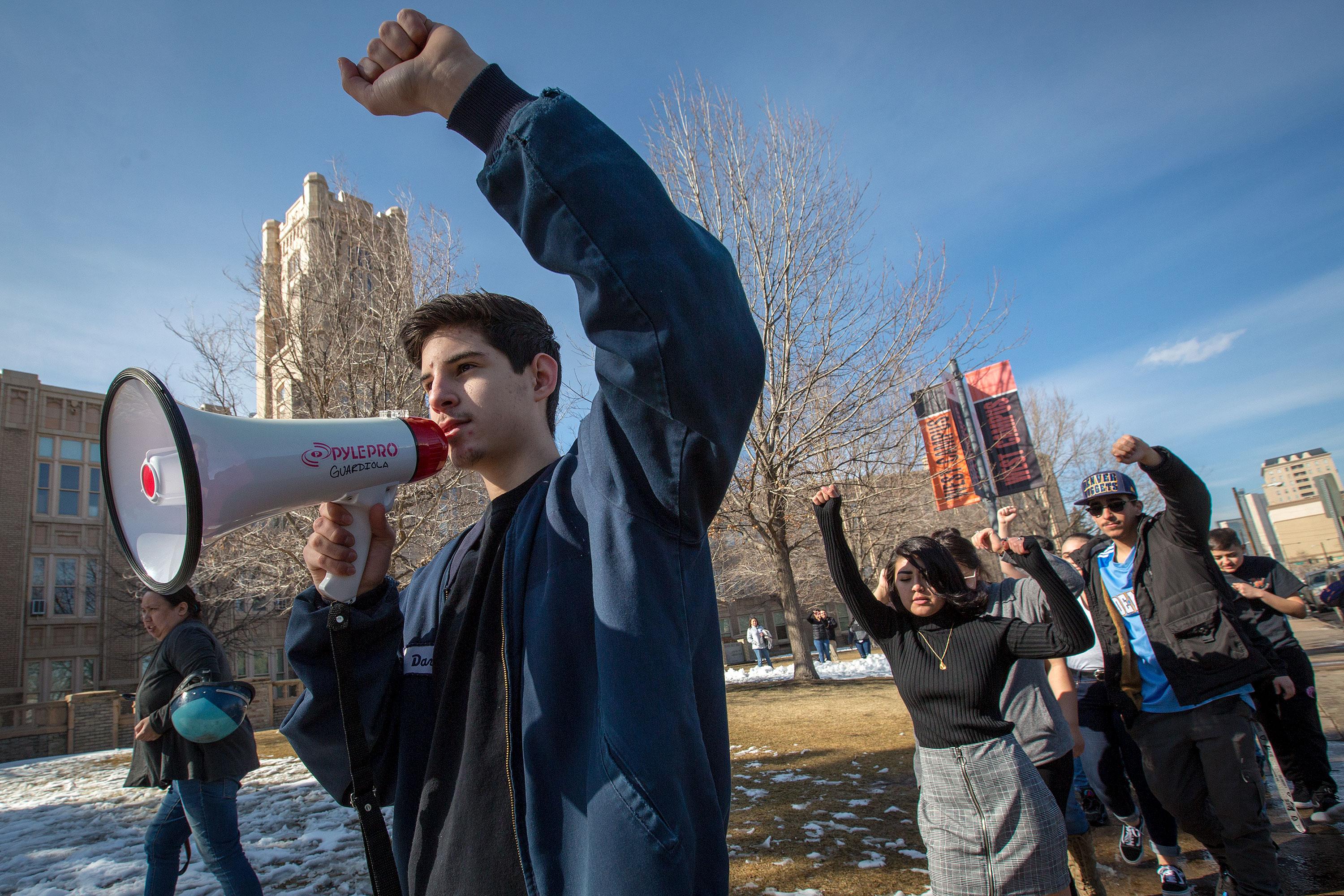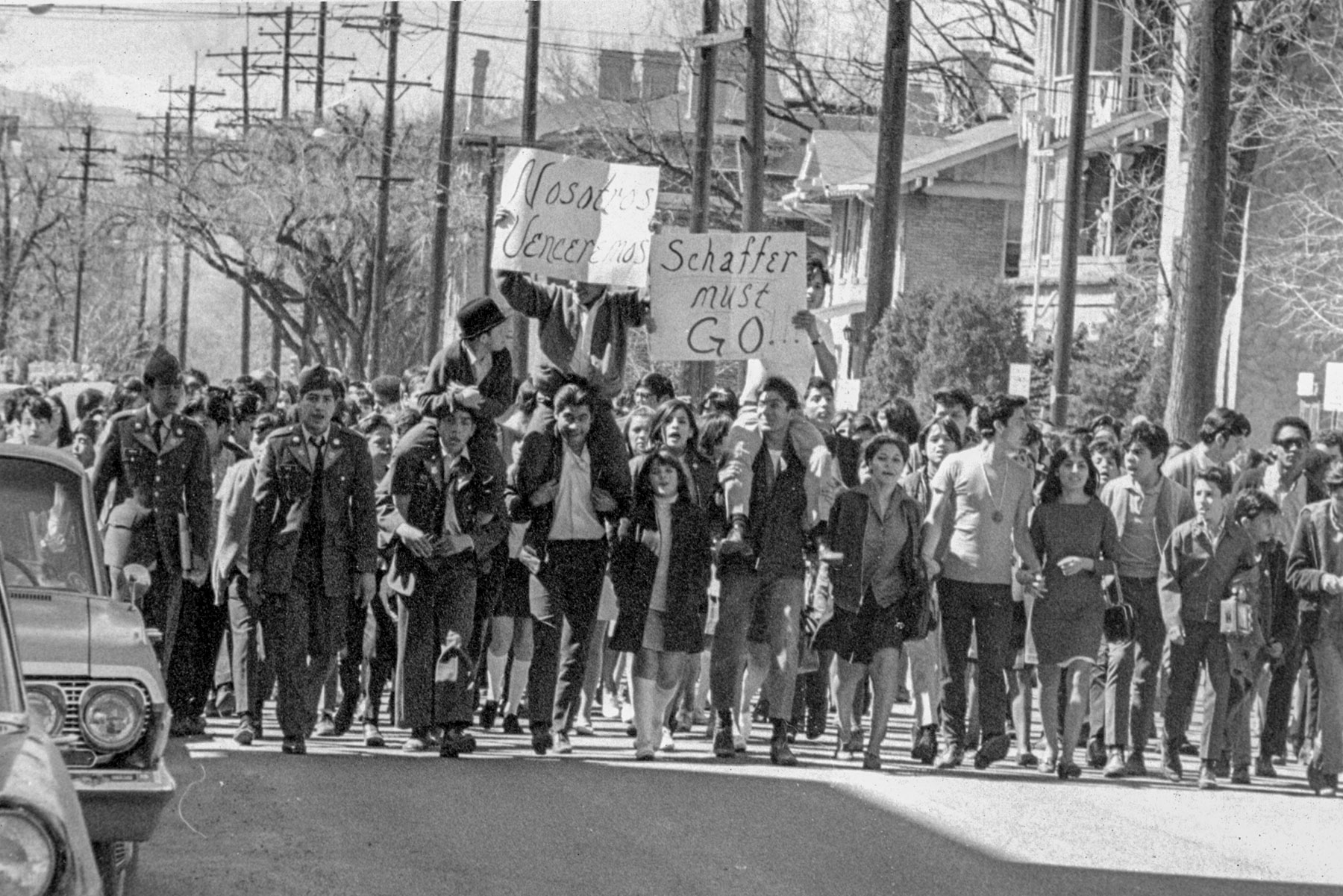
The sound of student laughter and conversation in the halls of Denver's West High School has a distinct timbre. Teenagers dash between classes and chat in a mix of Spanish and English.
Mia Martinez-Lopez, one of three Latina educational leaders at the multi-school campus, said there can always be improvements, but the progress made in terms of meeting students’ needs shouldn’t be overlooked. The use of all languages is encouraged. In fact, her entire office staff is bilingual — sometimes even trilingual.
“We have other Latino assistant principals,” she said. “A lot more teachers of color.”
Students don't just see themselves reflected in their teachers, but in what they learn too. Martinez-Lopez said they “offer Hispanic-American lit classes. We have Chicano studies.”
This might seem commonplace in a modern classroom, but this is West High. The scene here was far different 50 years ago.
In 1969, students were shamed by teachers if they spoke Spanish. Classes didn’t teach Chicano history or culture and a social studies teacher, Harry B. Shafer, intentionally mispronounced students’ names.
The teacher reportedly told students, “If you eat Mexican food, you’ll look like a Mexican” and “Spanish students are stupid because their parents are stupid.”
The Denver Post reported that students addressed their concerns with the administration, but weeks went by and nothing was done. Frustrations grew and it came to a head with a student walkout to protest discrimination.

Martinez-Lopez wasn’t even born then, but she knows the story well — because her father Emanuel Martinez was there.
“We learned about all the events of The Movement back when we were kids,” she said. “My dad would tell stories about what happened on that day. He had lots of stories about specific students and things he saw and the police brutality that was going on at the time.”
At 21, Emanuel Martinez was a member of the Crusade for Justice, a Denver group that fought for Chicano rights. Founded by Denver activist Rudolfo “Corky” Gonzales, who coined the term Chicano, the Crusade helped spark a national movement. The FBI, and many others, considered the group to be radical, so when they joined the student protests, police were ready.
On March 20, 1969, a few hundred students left West and crossed Elati Street to demonstrate at Sunken Gardens Park. Martinez was there with other members of the Crusade. Students then marched three blocks south to the now-defunct Baker Junior High, where Martinez said they rallied more students and headed back to West.
“By the time we got there, the police were already there in riot gear and ready for us with gas masks,” he said. “The whole thing.”
Thirty officers ordered demonstrators to leave school grounds and go back to Sunken Gardens.

Nita Gonzales, “Corky” Gonzales’ daughter and 18 at the time, participated in the walkout. She said she and some students were at the top of the stairs at the entrance of West when police began to push everyone back.
“Students started tumbling over,” she said. “They were grabbing me by my hair, by my shirts and coats and then my dad and the other adults got upset and tried to intervene and as a result, they were getting beat up.”
Fights broke out between officers and demonstrators, according to news accounts. Police used pepper spray to contain the violence.
Twenty-six were arrested, including Martinez, a news photographer and 11 juveniles. At least two were hospitalized, including a police officer. Martinez said he was handcuffed in the back of a police van and watched several officers struggle to put a teenage girl inside.
“They brought in a girl who was like... took about three or four policemen to get her in because she was wild,” he said.
Her ankle got caught in the door and police kept pushing on it, trying to get her inside, he said. Police doused everyone in the wagon with pepper spray from a hole in the roof. That left it cloudy inside the van and the detainees struggling, Martinez said.
“Your eyes are stinging, your skin and everything is just, you know, stinging like crazy.”
The protest didn’t end there.
Twenty-five squad cars were sent to the scene and a police helicopter hovered overhead. Demonstrators marched north to the Denver Police Building, City Hall and Mayor Bill McNichols’ office.
Gonzales said the walkout got bigger the next day, March 21, 1969, as students joined in from the city’s schools.
“Manuel, Thomas Jefferson, Lincoln, South, all came out and supported the students at West High School,” she said.
Members from the Students for a Democratic Society and the Black Panthers, two groups also considered extremely radical in the 60s, joined in. Martinez said at least 1,000 protestors were there.
“These were people of different races that supported the students and their grievances and their demands,” he said. “And this is when really, there is a riot that took place. Kids were throwing bottles and rocks and everything at the policemen and cars were destroyed.”
A newsreel produced by City of Denver Commission on Community Relations intoned that demonstrators “showered newsman, officers and bystanders with rocks, bottles and beer cans.” Scenes of broken glass and splatters of blood on the sidewalk, as well as actions against police were shown. Commentary from Corky Gonzales was included.
“We were not in the wrong,” Martinez said. “We tried to do things peaceful. We were basically there to hear what the leadership had to say and their grievances were legitimate. And we had no intention of being violent or anything like that.”
The demonstrations came to be known as the “blowouts” and the four days of unrest on the West side cost the city of Denver at least $25,000, the Rocky Mountain News reported.
Nita Gonzales said students presented a list of nine demands and wanted the social studies teacher fired.
“The ones that were critical in my mind was the curriculum,” she said. “Having a curriculum that represents us, that we’re in that history, in that story. To have more Chicano teachers, counselors and administrators.”
Then-Denver Public Schools Superintendent Robert D. Gilberts agreed to change the curriculum and the teaching staff. The teacher who insulted the students was not fired and instead was transferred to another school.

For Emanuel Martinez, the “walkouts did make a big impact on our community. More teachers were hired,” he said. “We just never really learn about these things that would give us, you know, a positive look at ourselves.”
The West blowouts helped kick-start what became known as El Movimiento, the Chicano Movement. Just a few weeks later, the Crusade for Justice held the first ever Youth Liberation Conference. Nearly 1,500 young Chicanos from across the country were drawn to Denver.
In the years that followed the 1969 West protests, different Chicano youth groups formed and there were anti-war demonstrations, walkouts in California and protests throughout the Southwest.
Ramon Del Castillo, a Chicano Studies professor at Metropolitan State University, said the blowouts were a movement catalyst and a lot of things came together at the right time.
“The beginning of Chicano Studies came from not just West but also that Youth Conference,” he said. “We’ve created a well-researched, methodologically sound discipline that’ll stand up to any other work in political science and sociology. We now have the scholarship and the scholars that do that.”
Artists, poetry, literature, music, dance and more came out of El Movimiento, he said.
Gonzales never left activism. She ran Escuela Tlatelolco, an alternative K-12 school born out of the Chicano Movement, and was recognized as a Champion of Change by the Obama Administration. The way West High students stood up still sticks out in her mind today.
“It was like a wildfire that just started to consume, travel across the states saying, ‘We have a right to stand up, we have a right to live a life that we have justice and equality and it’s not going to happen because someone feels sorry for us,’” she said. “It’s going to happen when we stand up, when we say ‘¡Ya basta! No more. We’re not doing this anymore.’”

Martinez is a successful artist with works found across Denver, the Southwest and in the Smithsonian. One of his latest efforts is an art installation for the school to recognize the protests. He sees the legacy of the blowouts today and even within his own family.
“The very thing we were fighting for, I think (Mia’s) living proof that it was effective,” he said.
His daughter leads West Early College now. And his 17-year-old grandson, Esai Lopez, a West student, is part of Al Frente De Lucha, a group that teaches young people Chicano history and culture.
Lopez wants people to be open minded and educate themselves.
“Whether it's watching more documentaries about something or reading a book about history, just to get to know the world better,” he said. “I think it’s important to stand for something.”
West High School will mark the 50th anniversary of the blowouts with a series of events in Denver, March 18-21, 2019









